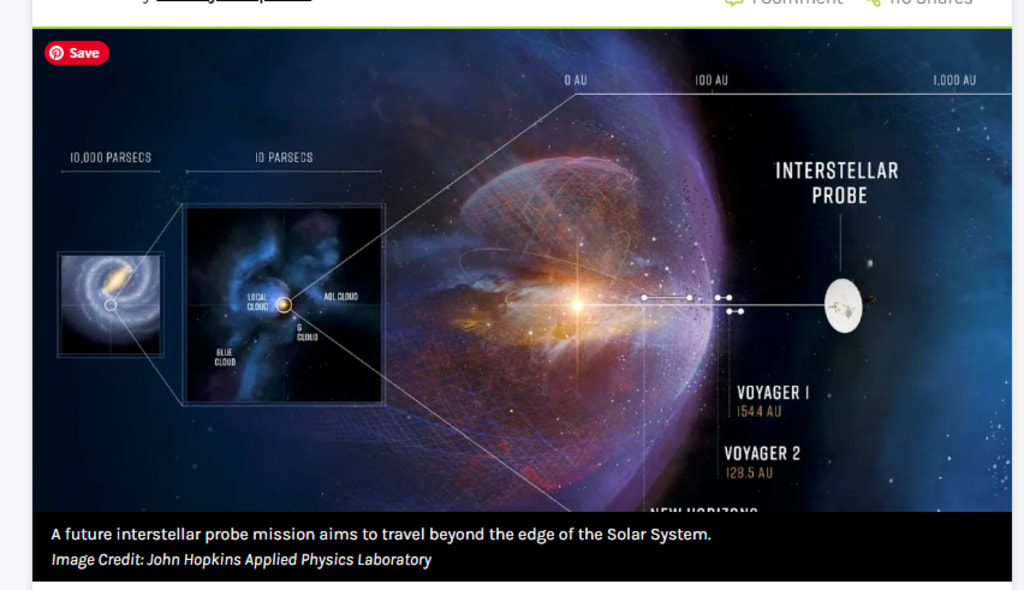The Best Way To Reach Interstellar Space And Leave The Solar System Is This
The optimal paths for a spacecraft to take to travel outside the Sun's influence have been sketched out by scientists.

Not too far away is interstellar space. Two of our probes have already been dispatched outside the heliosphere, which is the area where the Sun dominates space with its solar wind. Although our exploration of the interstellar medium has yielded significant discoveries, it is still insufficient to offer a comprehensive picture of our place in the galaxy.
One significant factor about which we know absolutely nothing is the heliosphere's form. Although the term implies a spherical shape, we are unsure of its exact shape. Instead of being spherical, models indicate that it might be stretched or perhaps crescent-shaped. better comprehend the heliosphere, researchers have finally determined where to put a probe.
"Without a mission like this, we are just goldfish trying to understand the fishbowl from the inside," stated University of Michigan first author Dr. Sarah A. Spitzer in a release.
"We want to know how the heliosphere protects astronauts and life in general from harmful galactic radiation, but that is difficult to do when we still don't even know the shape of our shield,"
The heliosphere is directional due to the effects of galactic radiation on its structure. The heliosphere is closest to the Sun on the nose side in the direction of motion of the sun. Additionally, there is the tail, which stretches somewhat like a boat's wake. A mission proposal for 2021 believed that a probe angled 45 degrees from the nose was the best potential direction. This new piece contradicts it.
To maximize scientific results, Spitzer and colleagues calculate the numbers of six alternative trajectories. Ultimately, it would require numerous years to exit the heliosphere. It was discovered that passing through the flanks would provide an excellent viewpoint for studying interstellar space and improving our understanding of the heliosphere's shape.
Voyager 1 and 2 are the two spacecraft in interstellar space. Their capacity to investigate the interstellar plasma has been restricted because they were not intended for this use, but rather to examine the massive planets. They also don't go too far from the nose. It may be possible to inject the interstellar plasma into the heliosphere at the tail. However, until we can get a close-up look at it from the outside, we can't be certain.
"Going out the front door and snapping a photo from the front pavement is probably not the greatest way to figure out how far back your house extends. To get the best idea of how long it is, exit from the side door.
"A future interstellar probe mission will be our first opportunity to see our heliosphere, our home, from the outside, and to better understand its place in the local interstellar medium," Spitzer said.
Voyager 1 is currently 163 astronomical units (AU) away from Earth and is having serious computer issues. The distance between Earth and the Sun is one astronomical unit (AU), and a probe following Spitzer and her team's route would reach 400 AUs before hopefully surviving to reach 1,000 AUs over several decades.
"A lot of perseverance was needed for this analysis. Susan Lepri, a professor of climate and space sciences and engineering at the University of Michigan and the study's principal author, stated, "It started small and grew into a great resource for the community."
To determine what might have gone wrong and how it could be fixed, the team is now comparing the newly decoded signal with data received before September. "But an engineer with the agency's Deep Space Network, which operates the radio antennas that communicate with both Voyagers and other spacecraft traveling to the Moon and beyond, was able to decode the new signal and found that it contains a readout of the entire FDS memory."






Comments
There are no comments for this story
Be the first to respond and start the conversation.